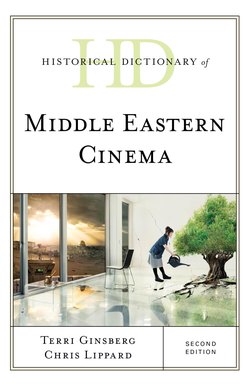Historical Dictionary of Middle Eastern Cinema

Реклама. ООО «ЛитРес», ИНН: 7719571260.
Оглавление
Terri Ginsberg. Historical Dictionary of Middle Eastern Cinema
Editor’s Foreword
Preface
Reader’s Note
Acronyms and Abbreviations
Chronology
Introduction
Cinema in the Middle East
Cinema and Nation in the Middle East
Transnationalism in the Middle East
The Form of the Historical Dictionary in Theory
A Note on What Is Not Here
A
B
C
D
E
F
G
H
I
J
K
L
M
N
O
P
Q
R
S
T
U
V
W
Y
Z
Filmography
Bibliography. Contents. Introduction
General References. Middle Eastern Film and Culture: Theory and Criticism
Maghrebi and Beur Film and Culture
Cinemas of the Middle East. Algeria
Bahrain
Egypt
Iran
Iraq
Israel
Jordan
Lebanon
Morocco
Palestine
Qatar
Saudi Arabia
Syria
Tunisia
Turkey
United Arab Emirates
Western Sahara
Yemen
About the Authors
About the Contributors
Отрывок из книги
No region has faced more adversity over the past half century or so than the Middle East: foreign colonization, the struggle for liberation, often followed by coups d’état, revolutions, international and civil wars, repressive government, economic problems (though not for the oil producers), generational and gender conflicts, and more. To this must be added the “isms”: nationalism, socialism, neoliberal capitalism, orientalism, Islamism, and Zionism, as well as the more general bane of censorship. This is certainly not a conducive atmosphere for cinema to flourish . . . or is it? These challenges have compelled Middle Eastern directors, producers, actors, and others to try harder. In many cases, they have succeeded in overcoming all adversity and producing excellent films, and when that was not possible impressive documentaries in their respective countries and abroad. Knowing their own people better, they have produced works that overcome the encroachment of Hollywood and Bollywood and encourage nationals to think more seriously about their own societies. This could be the main strength of Middle Eastern cinema; it deals seriously with serious issues, although as elsewhere—and given the need for escapism—it also produces comedies, farces, adventure films, and even some relatively “naughty” films.
The authors of this now second edition of the Historical Dictionary of Middle Eastern Cinema have certainly done an exceptional job of exploring and explaining one of the least-known areas of cinema, but one that deserves to be known better. As in other books in this series, this book sets the scene with a chronology, one longer and more extensive than one might expect, and then an introduction, which is certainly more complex than most. But the bulk of the material is contained in a dictionary section full of informative entries on the various countries concerned and the composite regions; their directors, producers, and actors; dozens of the better films; most of the genres; and many of the themes, from exile to gender and sexuality. Other entries deal with significant political leaders and events, including the Arab–Israeli conflict, the Defeat, and the Iraq War, which have generated films. And mention is also made of film schools, festivals, and currents, such as New Realism and Third Cinema. In short, the field of cinema is studied from many different angles, and it would not be easy to find more in a smaller space. Finally, for those who want to learn more, there is a bibliography with further reading on cinema in the region and in each part as well. Nor should one forget the amazingly long filmography.
.....
2009 Algeria: The National Amazigh Film Festival begins in Tizi Ouzou. Iran: Opposition to disputed election results in Iran is partly coordinated and publicized online through the use of YouTube and Twitter. Palestine: Amreeka (Cherien Dabis), arguably the first Palestinian American feature film, is released to critical acclaim in North America.
2010 Iraq: August: The United States begins combat troop withdrawal from Iraq. Israel: The Reut Institute codifies the hasbara project in “Building a Firewall against Israeli Delegitimation: Conceptual Framework.” Jordan: The Karama Human Rights Film Festival is established in Amman.
.....